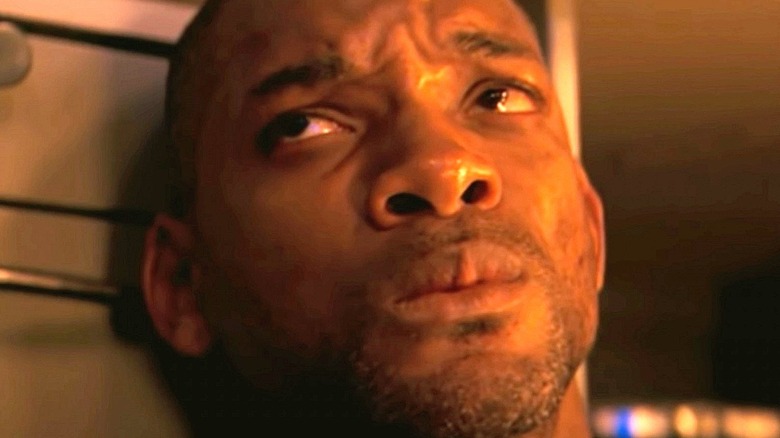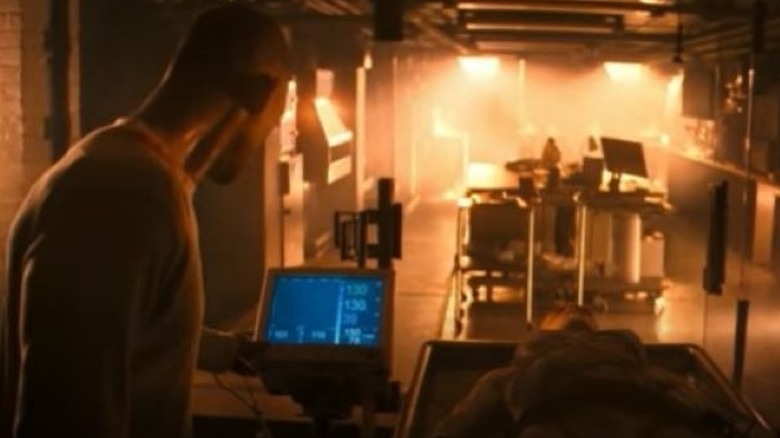The I Am Legend Detail That Has Fans Looking Twice At The Infected
Nearly everyone has a favorite post-apocalyptic story, but many of today's hottest franchises can trace their origins all the way back to the 1954 novel "I Am Legend" by Robert Matheson.
Most of the influence of "I Am Legend" on pop culture has been indirect — the novel's so-called "vampires," for instance, are often credited with being the inspiration of the undead zombies we know today, since Matheson's work directly inspired George A. Romero's iconic "Night of the Living Dead" (per Far Out Magazine) — but there have been direct adaptations, including Vincent Price's "The Last Man on Earth" (1964), Charlton Heston's "The Omega Man" (1971), and the 2007 Will Smith vehicle, "I Am Legend."
Smith's "I Am Legend" follows Robert Neville (Will Smith) as he lives a life of solitude in New York City after a widespread pandemic destroys all life as he knows it. Very possibly the last man on Earth, Neville spends his time searching for a cure to the virus, which turns its victims into zombies — here, referred to as Darkseekers. Neville lives his days hunting wildlife in the streets of Times Square, hanging out with his dog, and capturing infected people and taking them back to his lab to test his cures on them in hopes of bringing them back to "normal."
With the vast number of zombie movies and post-apocalyptic films out there, it is easy to look at "I Am Legend" as a pretty straightforward narrative, particularly when compared to the definitively darker book that inspired it. However, what if we don't actually know the whole story of the infected?
A recent theory circulating online suggests that there is a detail we missed about the creatures, raising the question of whether we have misunderstood the film for the last 15 years.
Neville was the true villain
The film seemingly sets up the Darkseekers as the villains, with Neville locking himself in his home at night, listening to the terrifying sounds of them feeding outside his fortified door. He is careful not to enter dark buildings during the day, knowing that is where they sleep to avoid the sun. The film even gives Neville a primary antagonist, via an alpha male (Dash Mihok) who plays a big role in the climax.
But what if Neville is the villain?
Reddit user u/J_Schermie posits that the movie gives us all the evidence we need to see that Neville was not only the bad guy, but the infected were afraid of him. Essentially, the Darkseekers have formed their own society, which Neville is so prejudiced against (due to being so connected to the pre-pandemic human society that he lost) that he doesn't realize they're trying to go about their lives, watching him fearfully as he rolls around blaring music and attacking them whenever they cross paths. As the user points out, "After he sets his trap, we see the one infected guy get super-pissed, exposing himself to sunlight just so he can glare at the doctor." Furthermore, based on the Darkseekers observing Neville, they probably knew where his home was the whole time — and only acted aggressively when he took captive the alpha male's lover.
This theory actually makes the movie line up closer to the unforgettable ending of Matheson's book, as pointed out by another Redditor: "Basically he realizes that they're not actually mindless, and that he himself is the monster of the story that's been hunting and killing these people."
Unlike many internet theories, this hypothesis holds serious weight, and makes the movie far more powerful than it initially seems.

